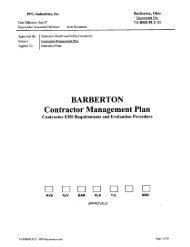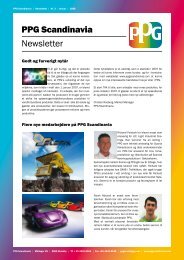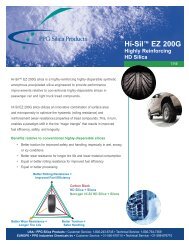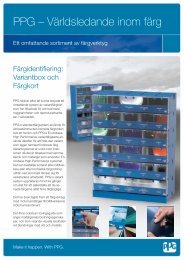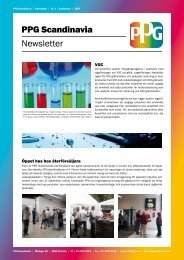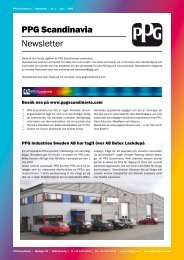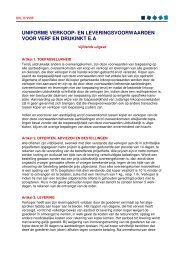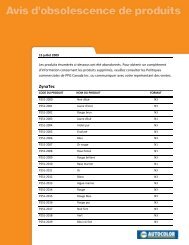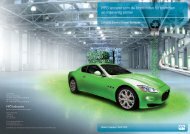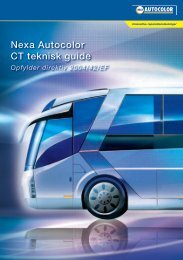RR_v65-3.indd - PPG Industries
RR_v65-3.indd - PPG Industries
RR_v65-3.indd - PPG Industries
Create successful ePaper yourself
Turn your PDF publications into a flip-book with our unique Google optimized e-Paper software.
8<br />
S H O P C O S T S R I S I N G :<br />
Time to Ask Your Tape,<br />
“What Have You Done for Me Lately?”<br />
In almost every industry, people continually look<br />
for ways to increase performance levels while<br />
lowering costs. In the paint and body shop business,<br />
the solution may be as easy as upgrading a tool you use<br />
everyday to something that lasts longer and/or gets<br />
better results more consistently. Take, for instance,<br />
masking tape.<br />
In today’s changing market,<br />
new paint chemistries and higher<br />
temperature bake cycles place great<br />
physical demands on masking tapes.<br />
In the automotive refinish industry,<br />
applying masking tape accounts for<br />
six percent of labor revenue generated<br />
on repair orders, or $56 on a<br />
typical repair order of $2,000. Since<br />
productivity equals profitability,<br />
consider how much time is spent<br />
performing compensating behaviors<br />
caused by the performance limitations<br />
of low priced masking tapes.<br />
Megan Scherb, masking solutions<br />
business manager for 3M Automotive<br />
Aftermarket Division, explains that<br />
most painters, without realizing it,<br />
have changed their behavior<br />
to compensate for the<br />
limitations of lower priced<br />
tape. She notes, for<br />
example, that before<br />
spraying, painters<br />
typically inspect the<br />
vehicle to ensure the<br />
masking tape has<br />
not lifted since<br />
application. If it<br />
has, they must<br />
spend time pressing<br />
the tape down in<br />
order to prevent paint<br />
blow-by. Compensating behaviors<br />
such as these require extra time that<br />
could be used more productively<br />
on revenue generating activity.<br />
It seems that to save money in one<br />
area (labor) you must spend more<br />
money in another (supplies), but<br />
sometimes the costs for better materials<br />
are minimal compared to productivity<br />
gained, so it’s important to do your<br />
research and compare costs. To illustrate<br />
the productivity advantage that<br />
Scotch ®<br />
Performance Masking Tape<br />
233+ brings to a paint job, 3M has<br />
designed an interactive value analysis<br />
tool. The tool helps the shop owner or<br />
manager understand the value of the<br />
time gained by utilizing the shop’s<br />
specific operating costs. “Masking<br />
tape can have a big impact on labor<br />
revenue while contributing a relatively<br />
small amount to material costs.<br />
Because of its excellent performance,<br />
using Scotch ®<br />
Performance Masking<br />
Tape 233+ may improve masking<br />
productivity up to 10 percent per<br />
repair order by eliminating extra<br />
steps,” says Scherb.<br />
Scotch ®<br />
Performance Masking Tape<br />
233+ is ideal for all body shop paint<br />
masking applications. According to<br />
Scherb, its balanced construction<br />
provides excellent adhesion with clean<br />
removal—even from difficult surfaces<br />
like EPDM rubber moldings,<br />
after contact with moisture<br />
and chemicals or prolonged<br />
outdoor exposure—all<br />
qualities that can contribute<br />
to increased productivity.<br />
For more information<br />
about Scotch ®<br />
Performance<br />
Masking Tape 233+, visit<br />
3M’s Web site at www.3M.<br />
com/automotive or call 1-<br />
877-MMM-CARS (1-877-<br />
666-2277). ■<br />
3M and Scotch are trademarks of 3M Company.<br />
P o w e r P r e c i s i o n<br />
The of<br />
No matter what method is used<br />
for preparing panels for clearcoat and<br />
color blends—traditional DA sanding<br />
discs, wet sanding sheets or scuff<br />
pads—all present obstacles to achieving<br />
a premium finish that results in an<br />
undetectable blend. For example,<br />
scuff pads conform very well to the<br />
panel surface but do not remove all<br />
gloss which can result in clearcoat<br />
adhesion failures. Scuff pads also have<br />
a tendency to leave deep scratches<br />
which may show through on metallic<br />
and pearl colors. Abrasives such as<br />
DA Discs and wet sanding sheets sand<br />
aggressively and remove more gloss,<br />
but do not offer the conformability of<br />
a scuff pad. This lack of conformability<br />
often leaves shiny spots that remain<br />
in the lower areas of the texture or<br />
“orange peel”. To remove this<br />
remaining gloss, the technician will<br />
not only spend additional sanding time<br />
but also increase the risk of sanding<br />
or “burning” through on an edge,<br />
contour or body line. The result is<br />
additional time spent reworking this<br />
previously undamaged area.<br />
3M, the industry leader in abrasive<br />
technology has recently introduced the<br />
company’s most advanced product for<br />
clearcoat and color blending. The<br />
3M TM<br />
Trizact TM<br />
Hookit TM<br />
II Blending<br />
Disc is a foam-backed abrasive disc<br />
designed to conform to the sanding<br />
surface with minimal risk of burn<br />
through on edges, contours or body<br />
lines. The foam backing allows the<br />
disc to conform and sand deep into<br />
orange peel with minimal texture<br />
removal while producing a consistent<br />
matte finish with no “shiny spots,”<br />
something that is difficult to achieve<br />
with traditional DA discs or wet<br />
sanding abrasives. The finish left by<br />
the Trizact TM<br />
Hookit TM<br />
II Blending Disc<br />
makes deep scratch and adhesion<br />
concerns a thing of the past.<br />
The key to Trizact’s excellent<br />
performance is the combination of<br />
its foam backing and unique mineral<br />
construction, which is made up of<br />
micro-replicated, pyramid-shaped<br />
structures. This construction ensures<br />
that fresh mineral is exposed at a<br />
uniform rate, extending the life of<br />
the product while maintaining a<br />
consistent level of cut. Most<br />
importantly, the uniform scratch<br />
pattern left by the Trizact TM<br />
Hookit TM<br />
II Blending Disc allows metallic and<br />
pearl colors to lay down uniformly<br />
resulting in blends that are virtually<br />
transparent which will certainly appeal<br />
to your customer and increase your<br />
shop’s CSI.<br />
For more information about<br />
Trizact TM<br />
Hookit TM<br />
II Blending<br />
Discs from 3M, visit 3M’s Web<br />
site at www.3M.com/automotive<br />
or call 1-800-3M-HELPS (1-800-<br />
364-3577). ■<br />
3M, Trizact, and Hookit are trademarks of<br />
3M Company.<br />
The Process of Precision<br />
STEP 1<br />
STEP 2<br />
STEP 3<br />
SANDING LARGE AREAS<br />
1a. CLEAN the repair area with soap and water,<br />
followed by 3M TM<br />
General Purpose Adhesive Cleaner.<br />
1b. Using a spray bottle, apply enough water to<br />
dampen the 3M TM<br />
Trizact TM<br />
Hookit TM<br />
II Blending<br />
Disc before sanding the panel. DAMP SAND the<br />
entire blend area, including bodylines and edges,<br />
with a DA sander. When necessary, re-dampen<br />
disc with water from spray bottle while sanding.<br />
SANDING HARD-TO-REACH AREAS<br />
Remove Blending Disc from backup pad to sand<br />
hard-to-reach areas and edges.<br />
CLEANING<br />
Wipe off blend area immediately.<br />
9



